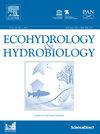First characterization and spatial distribution of microplastics in Sardina pilchardus fish gathered along the northern Tunisian coast
IF 2.2
4区 环境科学与生态学
Q2 ECOLOGY
引用次数: 0
Abstract
The growing concern of microplastic (MP) accumulation in oceans presents a threat to marine life and ecosystems. The present study investigates the presence of MPs in Tunisia's most-consumed fish species, Sardina pilchardus, sampled from various sites along the northern Tunisian coast, including Tabarka, Bizerte, La Goulette, and Kelibia. From a total of 40 fish specimens examined (n = 10 per site), results revealed that 92.5 % had MPs in their digestive tracts, and 72.5 % had MPs in their gills. MP concentrations ranged from 1.1 ± 0.99 to 5.86 ± 3.39 particles per individual in the digestive tract and from 1.2 ± 2.25 to 4.00 ± 3.67 particles per individual in the gills. The highest MP concentrations were observed in sardines caught off the coast of Bizerte. MPs identified in three types as fibres, fragments, and films and in various colors, including black, clear, blue, red, green, and white. The majority of MPs found in both the digestive tract and gills were fibres. Additionally, the smallest size class (ranging from 0.033 to 0.5 mm) dominated in both tissues of the sardine. These findings raise concerns and serve as a reference point for understanding the extent of MP pollution along the northern coast of Tunisia. They also suggest considering sardines as potential bioindicators of marine plastic ingestion.
突尼斯北部沿海沙丁鱼中微塑料的首次表征和空间分布
海洋中微塑料(MP)的积累日益受到关注,对海洋生物和生态系统构成威胁。目前的研究调查了MPs在突尼斯最常食用的鱼类沙丁鱼中的存在,从突尼斯北部海岸的不同地点取样,包括塔巴尔卡、比塞特、拉古莱特和克里比亚。总共检查了40个鱼标本(每个地点n = 10),结果显示92.5%的鱼在消化道中有MPs, 72.5%的鱼在鳃中有MPs。MP在消化道中的浓度范围为1.1±0.99至5.86±3.39颗粒/人,在鳃中为1.2±2.25至4.00±3.67颗粒/人。在比塞大海岸捕获的沙丁鱼中观察到最高的MP浓度。MPs分为三种类型:纤维、碎片和薄膜,并有各种颜色,包括黑色、透明、蓝色、红色、绿色和白色。在消化道和鳃中发现的大多数MPs都是纤维。此外,最小的尺寸类别(范围从0.033到0.5毫米)在沙丁鱼的两个组织中都占主导地位。这些发现引起了人们的关注,并为了解突尼斯北部海岸的MP污染程度提供了参考点。他们还建议考虑将沙丁鱼作为海洋塑料摄取量的潜在生物指标。
本文章由计算机程序翻译,如有差异,请以英文原文为准。
求助全文
约1分钟内获得全文
求助全文
来源期刊

Ecohydrology & Hydrobiology
Agricultural and Biological Sciences-Aquatic Science
CiteScore
5.40
自引率
3.80%
发文量
51
期刊介绍:
Ecohydrology & Hydrobiology is an international journal that aims to advance ecohydrology as the study of the interplay between ecological and hydrological processes from molecular to river basin scales, and to promote its implementation as an integrative management tool to harmonize societal needs with biosphere potential.
 求助内容:
求助内容: 应助结果提醒方式:
应助结果提醒方式:


